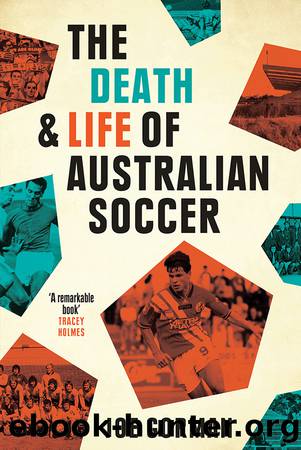The Death and Life of Australian Soccer by Gorman Joe;

Author:Gorman, Joe;
Language: eng
Format: epub
Publisher: University of Queensland Press
The case against clubs such as Sydney United was as old as the national league itself, underpinned by commercial logic and furnished by the aggressive identity politics of the era. By 1997 the Australian soccer community had completely lost faith in its ethnic institutions. They were castigated as being âmonoculturalâ and blamed for everything, from the gameâs poor image to the violence on the terraces â even for the collapse of Collingwood Warriors.
By contrast, the structure of the Brisbane Strikers was seen to encourage supporters and players from all different backgrounds to assimilate into a clear, unified Queensland identity. Glen Gwynne represented the tropical far north and Kasey Wehrman the remote north-west. Jeromy Harris came from Rockhampton, Clint Bolton from Bundaberg, Chay Hews from Toowoomba, Graham Ross from Townsville, Nick Meredith from the Sunshine Coast. And Alan Hunter, Wayne Knipe, and the Cranney brothers Troy and Sean were the Brisbane boys.
âThe extent to which the Strikers fitted into the Hill agenda was accidental,â remembered Bonita Mersiades, âbut there was a view around that for the game to grow it needed clubs that represented regions.â
At the beginning of the season, bookmakers had listed the Brisbane Strikers as 66â1 to win the title, and despite the team finishing second on the ladder, not a single Strikers player had been selected for the Socceroos. Yet everything, save for the form guide and the pundits, seemed to favour the Strikers. On the day before the game it rained, but on grand final day the sun came out. As the mascots parachuted into the stadium, Sydney Unitedâs stumbled and fell, while the Brisbane Strikers mascot landed flush on his feet.
By kick-off, Suncorp Stadium had to be locked for fears of overcrowding. Chay Hews had the first shot on goal within the opening minute, and Glen Gwynne expertly tracked Unitedâs danger man Kresimir Marusic, restricting his creative influence and cutting off supply to the forwards. Clint Bolton was a colossus in goals, rising high to comfortably catch the first Sydney United cross.
Just after half-time, Farina scored the opening goal with a left-foot stab that had just enough power and precision to trickle into the net. It was his 101st national league goal, and by far his most important. And when Rod Brown scored to make it 2â0, his tally rose to 131 NSL goals.
By the time the Brisbane Strikersâ assistant coach, Peter Tokesi, replaced Farina, there were just ten minutes left to play. Farina walked off to a standing ovation and a large banner that read, âThanks Frankâ. The official crowd figure was 40,446, a new national league record. On the other side of town, the Brisbane Broncos hosted the North Queensland Cowboys in rugby leagueâs Queensland derby. Less than 15,000 people turned up.
It was a stunning outcome, perhaps even more spellbinding than the Strikersâ victory itself, and as the players did their lap of honour Tokesi stood in the middle of the field and gazed up at a full stadium. For a man who had chosen to play soccer instead of rugby league at age 14, this felt like vindication.
Download
This site does not store any files on its server. We only index and link to content provided by other sites. Please contact the content providers to delete copyright contents if any and email us, we'll remove relevant links or contents immediately.
Futebol by Alex Bellos(1801)
No Hunger In Paradise by Michael Calvin(1565)
Pep Confidential by Martí Perarnau(1492)
Sir Matt Busby by Patrick Barclay(1285)
The Game of Our Lives by David Goldblatt(1237)
Cyrille Regis: My Story by Cyrille Regis(1235)
ALEX FERGUSON My Autobiography by Alex Ferguson(1223)
Football's Strangest Matches by Andrew Ward(1199)
No Nonsense by Joey Barton(1180)
The Lost Boys by Ed Hawkins(1149)
Cristiano Ronaldo: The Biography by Guillem Balague(1141)
Angels with Dirty Faces by Jonathan Wilson(1131)
Red Card by Ken Bensinger(1101)
Soccer Men: Profiles of the Rogues, Geniuses, and Neurotics Who Dominate the World's Most Popular Sport by Simon Kuper(1032)
We Are the Damned United by Phil Rostron(975)
A Season With Verona by Tim Parks(973)
Scholes : My Story (9781471125799) by Scholes Paul(950)
Eight World Cups by George Vecsey(921)
50 Complete Goalkeeping Training Sessions by Hageage Tamara Browder(916)
